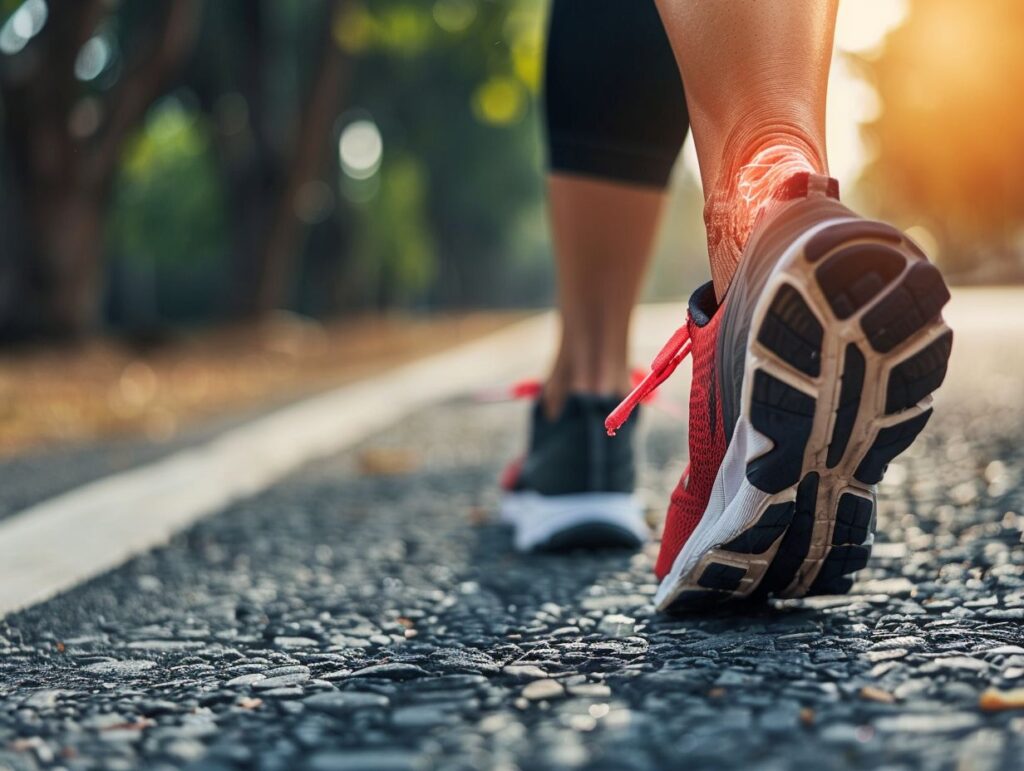Are you experiencing pain in your calf while running? This article explores the causes of discomfort, including muscle strain, shin splints, Achilles tendonitis, and compartment syndrome.
We also provide insights on preventing and treating calf pain, such as proper warm-up, gradual intensity increase, and rest days.
Learn when to seek medical attention and how to prevent future pain through strengthening exercises and proper training techniques. Let’s get you back on track pain-free!
What Causes Pain in the Calf While Running?
Pain in the calf while running can be caused by various factors including muscle strain, shin splints, Achilles tendonitis, and compartment syndrome. These conditions can result from overuse, improper form, inadequate warm-up, or muscle fatigue.
- Muscle strain typically presents with sharp pain in the calf muscle during or after running, accompanied by swelling and tenderness. Athletes engaging in activities like sprinting may be more prone to this injury due to the explosive muscle contractions involved. To prevent muscle strain, it’s crucial to gradually increase training intensity and incorporate proper stretching routines.
- Shin splints, characterized by a dull ache along the inner edge of the shin bone, often affect runners who suddenly increase their mileage. Jogging regularly on hard surfaces can exacerbate this condition, requiring proper footwear and gradual mileage increments to prevent it.
- Achilles tendonitis, indicated by pain and stiffness in the back of the ankle, can hinder marathon training, especially for individuals with tight calf muscles. Adequate rest between training sessions and incorporating strengthening exercises can help prevent this overuse injury.
- Compartment syndrome, marked by severe pain, numbness, or weakness in the calf during exercise, can impact runners, particularly during intense workouts like interval training. A proper warm-up routine that includes dynamic stretches can reduce the risk of developing compartment syndrome by improving muscle flexibility and blood flow.
Muscle Strain
Muscle strain in the calf is a common injury among runners, characterized by pain, discomfort, or cramping in the affected area. It can occur due to overexertion, inadequate warm-up, or muscle imbalance.
There are different types of calf muscle strains, including Grade 1, Grade 2, and Grade 3 strains, each varying in severity. Symptoms of calf muscle strain may include swelling, bruising, limited range of motion, and difficulty bearing weight on the affected leg.
To treat calf muscle strains, rest, ice, compression, and elevation (RICE) therapy is often recommended. Gentle stretching, foam rolling, and gradual strengthening exercises can help in the recovery process.
Prevention of future calf muscle strains involves incorporating proper warm-up and cool-down routines, regular stretching, strength training, and allowing ample time for muscle recovery between workouts.
Shin Splints
Shin splints, a common running injury, cause pain and discomfort along the shin bone. Runners may experience tightness, soreness, and inflammation in the affected area, often due to overuse or improper biomechanics.
These symptoms can worsen during running or physical activities, making it crucial for individuals to address them promptly. One effective approach is through proper warm-up routines that help prepare the muscles and reduce the strain on the shins.
Gait analysis is another valuable tool in identifying any biomechanical issues that may contribute to shin splints, allowing for targeted interventions. Rest and appropriate recovery time are essential in allowing the shin muscles to heal and prevent further damage.
Sports medicine professionals and physical therapists play a vital role in diagnosing, treating, and preventing shin splints by providing tailored exercises and guidance to improve muscle strength and flexibility.
Achilles Tendonitis
Achilles tendonitis, an overuse injury affecting the tendon at the back of the calf, can cause pain, stiffness, and discomfort during running activities. It is commonly seen in athletes who engage in repetitive movements like sprinting or distance running.
Risk factors for Achilles tendonitis include wearing improper footwear that does not provide adequate support or cushioning, as well as having weak calf muscles that cannot handle the stress of repetitive running.
Treatment options for this condition often involve rest, ice, and anti-inflammatory medication to reduce pain and swelling. Stretching exercises can help to improve flexibility and strengthen the tendon. It is crucial for individuals to gradually return to their normal activity levels after recovering from Achilles tendonitis to prevent re-injury.
Proper sports training techniques, focusing on form, flexibility, and strength, can also play a significant role in preventing the development of this painful condition.
Compartment Syndrome
Compartment syndrome in the calf involves increased pressure within muscle compartments, leading to pain, tightness, and swelling. This condition can be chronic or acute and may require medical intervention for relief.
If left untreated, compartment syndrome can progress rapidly, causing severe muscle and nerve damage. Symptoms may also include numbness, tingling, and weakness in the affected limb.
To diagnose compartment syndrome, healthcare providers may conduct physical exams, measure compartment pressures, and assess muscle function. It’s crucial to recognize early signs of muscle damage and seek immediate medical attention if experiencing persistent or worsening pain.
Treatment options for compartment syndrome may range from conservative measures like rest and ice to surgical interventions to release the pressure within the affected compartments.
How to Prevent Pain in the Calf While Running?
Preventing pain in the calf while running involves implementing proper warm-up routines, wearing appropriate footwear, staying hydrated, and allowing for adequate rest between intense workouts. These preventive measures can help reduce the risk of muscle strains and discomfort during physical activity.
Hydration is key to maintaining muscle function and preventing cramping in the calf muscles. When you are well-hydrated, your muscles are better able to perform optimally, reducing the likelihood of stiffness and pain.
Proper footwear provides support and cushioning for your feet and legs, reducing the impact on your calf muscles during each stride.
Rest is essential for muscle recovery and repair, allowing your calf muscles to heal and strengthen after strenuous workouts.
Incorporating a dynamic warm-up and cooldown routine into your running regimen can improve flexibility, strength, and endurance, further reducing the risk of calf pain and injury.
Proper Warm-up and Stretching
A crucial aspect of preventing calf pain while running is engaging in a proper warm-up routine that includes dynamic stretches to prepare the muscles for the activity. This warm-up helps reduce the risk of muscle strains and cramps during exercise.
By incorporating dynamic stretching exercises like calf raises, ankle circles, and walking lunges into your warm-up routine, you can specifically target the calf muscles. These exercises promote increased blood flow, flexibility, and range of motion in the calves, making them more resilient to the demands of running. Maintaining flexibility in the calves through regular stretching not only reduces the likelihood of muscle injuries but also enhances overall performance by allowing for a greater range of motion. Remember, a well-rounded warm-up is key to a successful and injury-free workout!
Gradual Increase in Intensity

To prevent calf pain while running, it is essential to gradually increase the intensity and duration of your workouts. Sudden spikes in activity levels can lead to muscle fatigue, overuse injuries, and strains in the calf muscles.
Incorporating a progressive training approach is key to building endurance and preventing muscle fatigue. By steadily increasing the intensity and duration of your runs, you allow your calf muscles to adapt and strengthen over time, reducing the risk of strain.
Integrating rest and recovery periods into your workout routine is essential for promoting muscle repair and overall physical fitness. Taking time off to allow your muscles to recover helps prevent burnout and allows your body to heal and grow stronger for future workouts.
Proper Footwear
Choosing the right footwear for running is crucial in preventing calf pain and injuries. Proper running shoes provide adequate support, cushioning, and stability to reduce the strain on the calf muscles during physical activity.
The selection of running shoes should be personalized based on individual foot arch, gait pattern, and running style. Understanding your foot arch type, whether it’s high, low, or neutral, can help determine the level of arch support needed in your shoes.
Analyzing your gait, such as overpronation or supination, is essential in finding the right footwear to maintain muscle balance and prevent tension. By choosing the most suitable running shoes, you can minimize the risk of calf strains and other potential running-related injuries.
Cross-training and Rest Days
Incorporating cross-training activities and rest days into your workout schedule can help prevent calf pain while running. Cross-training allows for muscle recovery and reduces the risk of overuse injuries, enhancing overall physical fitness.
It’s essential to engage in a variety of activities such as cycling, swimming, and strength training to target different muscle groups and improve overall muscle strength, agility, and flexibility. By varying your workouts, you challenge your body in new ways, preventing plateaus and improving your running performance.
Rest days are crucial for allowing your muscles to repair and grow stronger. Adequate rest helps in avoiding burnout and allows you to push harder in your training sessions, ultimately leading to better running results.
How to Treat Pain in the Calf While Running?
When experiencing pain in the calf while running, treatment options include rest, ice therapy, compression sleeves, and targeted stretching exercises. Physical therapy, massage therapy, and rehabilitation programs can also aid in the recovery process.
Physical therapy is highly recommended for addressing calf pain as it focuses on targeted exercises to strengthen the muscles and improve flexibility. Massage therapy helps in reducing muscle tension and improving blood circulation to the affected area. Rehabilitation programs offer a structured approach to gradually returning to normal physical activities while preventing future injuries. These treatment methods not only alleviate discomfort but also promote muscle recovery and overall rehabilitation of the calf muscles.
Rest and Ice
Resting the affected calf and applying ice can help reduce pain, inflammation, and muscle soreness. This treatment method is effective in managing acute injuries or strains and promoting recovery.
Applying ice to the calf should be done immediately following the injury to help minimize swelling and discomfort. It is recommended to apply ice for about 15-20 minutes at a time, every 2-3 hours for the first 48 hours after the injury. This helps constrict blood vessels, decrease inflammation, and numb the area to alleviate pain.
It’s essential to avoid applying ice directly to the skin, using a cloth or towel as a barrier, and giving the skin time to warm up between icing sessions to prevent any potential frostbite.
Compression and Elevation
Using compression sleeves and elevating the calf can help reduce swelling, stiffness, and discomfort. These methods improve circulation, reduce inflammation, and support the healing process for muscle injuries.
Compression therapy works by gently applying pressure to the calf muscles, enhancing blood flow and preventing fluid buildup. This increased circulation aids in flushing out toxins and reducing muscle soreness. Elevating the calf helps in draining excess fluid from the area, further decreasing swelling and promoting faster recovery. Together, these techniques play a crucial role in managing calf pain, enabling individuals to regain mobility and return to their daily activities with reduced discomfort.
Physical Therapy
Physical therapy plays a vital role in rehabilitating calf injuries, improving muscle function, and restoring mobility. Therapists use targeted exercises, manual techniques, and modalities to address pain, stiffness, and muscle imbalances.
For calf pain while running, physical therapists often incorporate specific exercises such as calf raises, ankle dorsiflexion, and eccentric heel drops to strengthen the muscles. Stretching exercises like soleus and gastrocnemius stretches can help increase flexibility and reduce tightness. Modalities like ultrasound therapy and electrical stimulation are commonly used to manage pain and promote healing. Soft tissue mobilization techniques such as massage and myofascial release can help improve blood flow and tissue elasticity in the injured calf muscle, aiding in the overall recovery process.
Medical Treatment

Seeking medical advice for persistent calf pain while running is crucial to receive a proper diagnosis and treatment plan. Sports medicine professionals can offer specialized care, diagnostic tests, and recommendations for managing sports-related injuries.
These experts have a deep understanding of the unique demands that running places on the body, allowing them to tailor their treatment plans to individual athletes. By consulting with a sports medicine specialist, runners can benefit from personalized medical advice that takes into account their specific condition, training regimen, and goals. This tailored approach not only helps in the effective management of calf pain but also aids in preventing future injuries, enhancing performance, and promoting overall athletic well-being.
When to Seek Medical Attention for Pain in the Calf While Running?
It is advisable to seek medical attention for persistent or severe pain in the calf while running, especially if the discomfort worsens or interferes with everyday activities. Sports medicine professionals can provide an accurate diagnosis and tailored treatment plan.
Consulting a medical expert becomes crucial when calf pain is accompanied by swelling, redness, or warmth in the area, as these could indicate a more serious underlying issue.
If the pain is sudden and sharp, or if there is a noticeable deformity in the calf muscle, immediate medical attention is necessary to rule out a potential muscle tear or rupture.
Seeking early intervention not only helps in properly managing sports-related injuries but also prevents complications that may arise from delayed treatment.
How to Avoid Pain in the Calf While Running in the Future?
Preventing future calf pain while running involves listening to your body’s signals, focusing on proper training techniques, incorporating strengthening exercises, and maintaining a routine of regular stretching and foam rolling to enhance muscle flexibility and resilience.
- Runners can benefit from implementing strategies such as gradually increasing mileage to avoid overworking the calves.
- Wearing proper footwear to support the arch of the foot.
- Warming up adequately before each run.
Developing a strong core and hip muscles can also help distribute the workload more evenly and reduce strain on the calves. It’s crucial to pay attention to any signs of discomfort and address them promptly to prevent minor issues from developing into more serious injuries.
Listen to Your Body
Paying attention to your body’s signals during running activities is crucial in preventing calf pain and potential injuries. Recognizing signs of muscle fatigue, weakness, or discomfort allows for timely adjustments to training intensity and techniques.
An important aspect of body awareness is understanding the difference between normal post-exercise soreness and more serious warning signs. For example, persistent sharp pain in the calf muscle, a sudden decrease in strength or endurance, or tightness that does not improve with stretching could all indicate the need to take a step back and reassess your running routine.
It’s essential to listen to your body, respect its limits, and proactively modify your training plan to avoid overuse injuries and setbacks.
Proper Training and Technique
Adopting proper training methods and refining running techniques are essential in minimizing the risk of calf pain and optimizing performance. Understanding biomechanics, gait analysis, and muscle balance can improve running efficiency and reduce strain on the calf muscles.
Biomechanics plays a crucial role in how the body moves during running and understanding this concept can help runners make adjustments to their form.
Conducting a gait analysis can provide valuable insights into any inefficiencies in the running stride, which, when corrected, can alleviate pressure on the calves.
Identifying and addressing muscle imbalances through targeted exercises can prevent overloading specific muscles and reduce the likelihood of injury.
By incorporating these strategies into training routines, individuals can enhance their overall calf health, performance, and enjoyment of running.
Strengthening Exercises
Incorporating targeted strengthening exercises for the calf muscles can improve stability, endurance, and resilience, reducing the likelihood of pain and injuries while running. Strengthening routines that focus on muscle weakness and tension areas enhance overall lower limb function.
By engaging in exercises like calf raises, both with straight and bent knees, individuals can specifically target the gastrocnemius and soleus muscles, essential for propulsion during running. Incorporating jump squats or box jumps can help enhance explosive power in the calf muscles, crucial for sprinting capabilities. Regular strength training not only builds muscle strength but also improves muscle coordination, balance, and flexibility, all of which are key in preventing muscle fatigue and spasms while running.
Regular Stretching and Foam Rolling
Incorporating regular stretching and foam rolling routines into your workout regimen promotes muscle flexibility, reduces stiffness, and aids in muscle recovery. These practices help prevent calf pain by maintaining optimal muscle elasticity and reducing post-exercise soreness.
By incorporating dynamic stretches like calf raises, downward dog stretches, and ankle circles, you can effectively target and stretch the calf muscles before and after runs to prevent tightness and potential injuries. Foam rolling techniques such as calf massages and using a foam roller to roll out tight spots can also aid in increasing blood flow and speeding up the recovery process for your calf muscles, enhancing overall performance and endurance during your runs.
Frequently Asked Questions

What causes pain in calf while running?
Pain in the calf while running can be caused by a variety of factors, including muscle strain, overuse, poor footwear, or underlying medical conditions.
How can I prevent pain in my calf while running?
To prevent pain in your calf while running, make sure to warm up properly before exercising, wear appropriate shoes, and gradually increase your running intensity and distance.
Is it normal to experience pain in calf while running?
It is common to experience some discomfort or tightness in the calf muscles while running, but persistent and severe pain could indicate an injury or underlying issue that should be addressed.
Can stretching help relieve pain in calf while running?
Stretching can help alleviate pain in the calf while running, as it can help improve flexibility and reduce muscle tension. Make sure to stretch properly and regularly for best results.
When should I seek medical attention for pain in calf while running?
If the pain in your calf persists or worsens despite rest and self-care measures, it is best to consult a medical professional for proper evaluation and treatment.
How long does it take for pain in calf while running to heal?
The healing time for pain in the calf while running depends on the severity of the injury or underlying condition. It is important to rest, ice, and gradually return to running under the guidance of a medical professional.

My passion for martial arts goes beyond practice; it is a philosophy that shapes my writing, bringing a distinctive edge to my narratives and advice. I hold black belts in two martial arts disciplines and have competed internationally, experiences that enrich my storytelling with authenticity and excitement.

